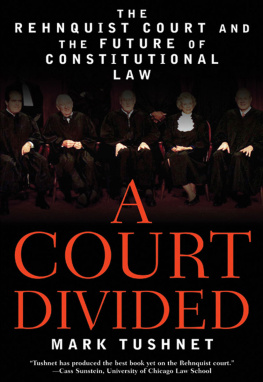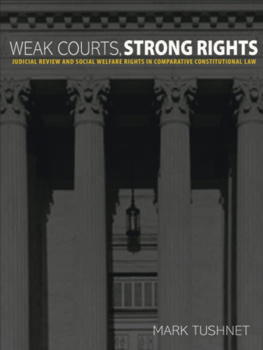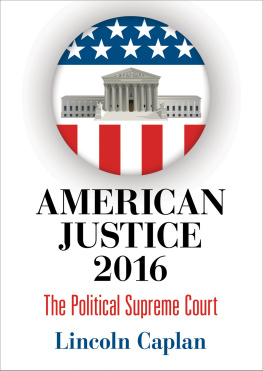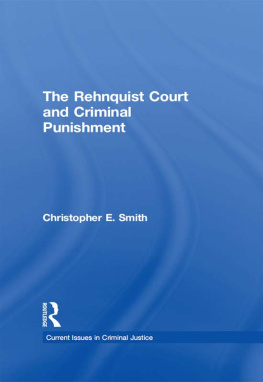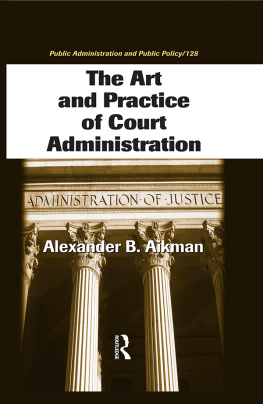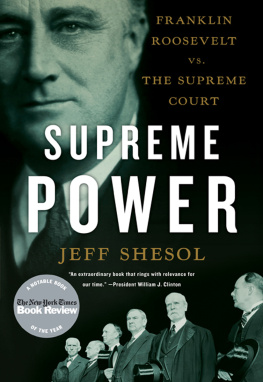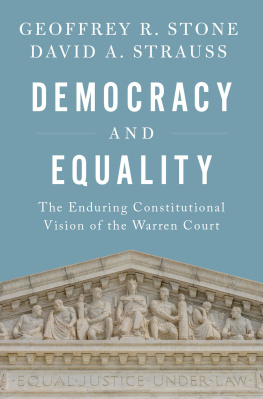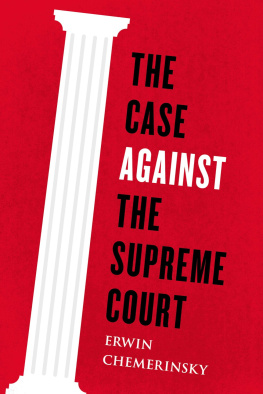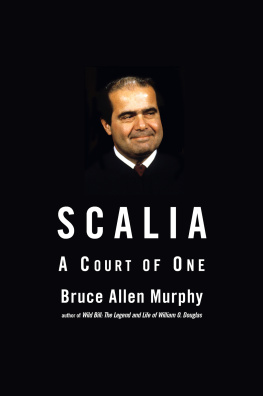A COURT DIVIDED
The Rehnquist Court and the Future of Constitutional Law
MARK TUSHNET

W. W. NORTON & COMPANY
New York London
Copyright 2005 by Mark Tushnet
All rights reserved
For information about permission to reproduce selections from this book, write to Permissions, W. W. Norton & Company, Inc., 500 Fifth Avenue, New York, NY 10110
Library of Congress Cataloging-in-Publication Data
Tushnet, Mark V., 1945
A Court divided: the Rehnquist court and the future of constitutional law / Mark
Tushnet.1st ed.
p. cm.
ISBN: 978-0-393-07751-3
1. United States. Supreme Court. 2. Political questions and judicial powerUnited States. 3. Constitutional lawUnited States. 4. Rehnquist, William H., 1924I. Title.
KF8742.T87 2005
347.73'26dc22
2004013786
W. W. Norton & Company, Inc., 500 Fifth Avenue, New York, N.Y. 10110
www.wwnorton.com
W. W. Norton & Company Ltd., Castle House, 75/76 Wells Street, London W1T 3QT
To the memory of
JUDGE GEORGE EDWARDS,
who taught me that its a privilege
to have the opportunity to serve
the American People
CONTENTS
INTRODUCTION
T he story of the Rehnquist Court is the story of a court divided not simply between liberals and conservatives but, more important, between two types of Republican. Justices speaking for the modern Republican Party, transformed by Barry Goldwater and Ronald Reagan, rejected the principles that animated our government from the New Deal through the Great Society. Sandra Day OConnor and David Souter drew on more traditional Republican Party themes to temper and resist a transformation of constitutional law. The Courts liberals mostly sat on the sidelines, happy to pick up the victories they could gain when the Courts Republicans divided.
The justices are neither villains nor heroes in some story about whether the United States is about to descend into tyranny or ascend into utopia. They are, rather, ordinary lawyers who have strong views about what the Constitution means, shaped by their personal experiences and their thoughtful consideration of arguments about what the Constitution means. Some of them have quirks, just as the rest of us do. But it would be a serious mistake to reduce their disagreements over the Constitution and its future to those quirks or to personal spats. To understand the Rehnquist Court, we have to look at the history that gave rise to the arguments about the Constitutions meaning and see how competing visions play out in specific legal settings. Its not enough to do a scorecard of conservative or liberal victories, although thats part of the story. The hardest, but the most important, part of the story of the Rehnquist Court is figuring out what conservatism about the Constitution is.
The Courts divisions meant that conservatives prevailedmore or lesson issues associated with the Republican Partys efforts to scale down the size of government, while losing rather consistently on the social issuesabortion, gay rights, and affirmative actionthat animated an important part of the partys base. Economic conservatives got some help from the Rehnquist Court even though they didnt need much assistance. In contrast, social issues conservatives might have benefited from the Rehnquist Courts help but didnt get nearly enough. The old-fashioned Republicans were reasonably sympathetic to the liberal side on these issues, while the Courts movement conservatives were dead set against that side but lost.
The reason the Courts economic conservatives won and its cultural conservatives lost is simple. In the arena of politics, economic conservatives were winning and cultural conservatives were losing. The economic conservatives dominated Congress and the presidency, making help from the Supreme Court less important to their cause, though they received some. The cultural traditionalists, on the other hand, needed major assistance but received little, as they were forced repeatedly to retreat. So the patterns discernible in the Rehnquist Courts decisions reproduced the patterns occurring in American politics generally.
That fact raises an obvious question: Why should anyone care about what the Supreme Court does if it is merely a reflection of the broader political and cultural worlds? The answer is that the Court can push some issues higher up on the public agenda (gay marriage after the gay rights decision in 2003) and some issues farther down (affirmative action after the Michigan affirmative action cases in the same year). It can eliminate laws that have fallen out of favor in the general culture (the 2003 gay rights decision barred sodomy prosecutions that few regarded as sensible anyway) but persist in some isolated areas or protect those laws in ways that allow the general culture to push forward elsewhere. Sometimesnot often, but sometimesa gap can open up between the Court and the culture, making the Courts decisions particularly important and stressful. And then theres always the entirely unexpected: Bush v. Gore resolving the 2000 election.
One reason for my writing this book is my frustration with most of what constitutional scholars have written for readers who arent specialists in constitutional law. Perhaps prodded by the journalists who call them for comments on breaking news, most scholars end up doing little more than cheering or booing the Courts decisions. I think that the general public ought to know about what the Supreme Court does, but I dont think that cheerleading for one or the other side really advances public understanding.
The civics book view of the Courtthat conservative and liberal justices divide over whether it should be restrained or activist and that they use original intent or contemporary values in interpretationis a fairy tale. Nothing like it goes on in the Rehnquist Court. Everyone is a judicial activist. The Rehnquist Court has invalidated laws whose constitutionality was clear under long-established doctrine, using novel analyses that it has sometimes acknowledged cannot be tied closely to the Constitutions text or original understandings. In addition, the Rehnquist Court has asserted, more strongly than the Warren Court, a primary role in enforcing the legal boundaries Congress has to respect, so much so that two respected scholars have written an important article with the accurate title Dissing Congress.
So the Rehnquist Court is a political court. For scholars, tying the Supreme Court to party politics is not all that new. The standard view of the Warren Court, for example, is that it worked in conjunction with the Democratic Party to implement a New Deal/Great Society vision of the Constitution. The Rehnquist Court resembles the Warren Court in implementing a constitutional vision associated with the nations dominant political party. What makes its story more complicated (and interesting) is that the Republican Party has remained a coalition of economic and cultural conservatives. The Republicans on the Court who would use the Constitution to advance the economic and cultural agendas of the modern Republican Party have been able to lay the groundwork for later advances. But their actual accomplishments have been meager because they have been thwarted, not by activist liberals or by Democrats but by Republicans uneasy about the Republican cultural agenda.

